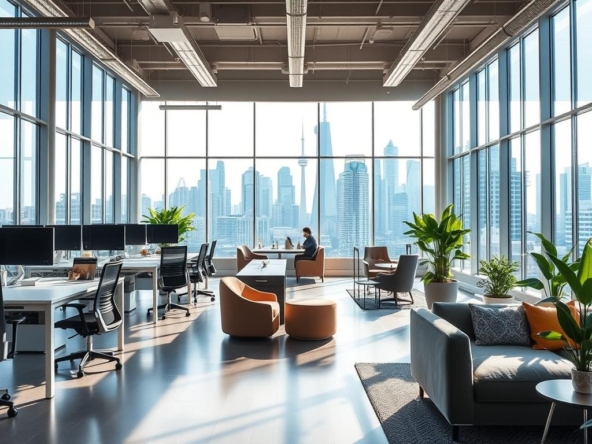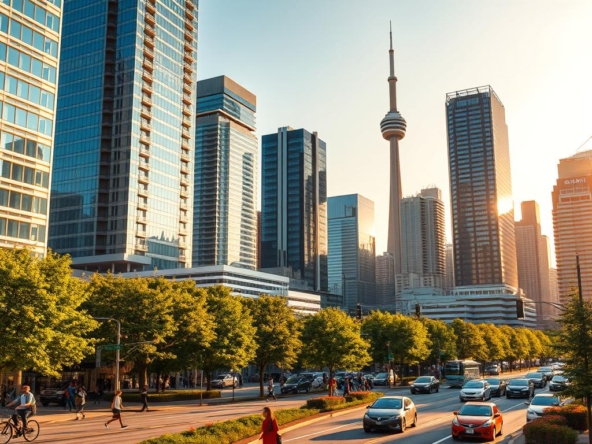Toronto, the vibrant heart of Canada, is a city that has captivated investors and homebuyers alike. It’s the country’s largest metropolis, with a thriving real estate market full of potential. Whether you’re an experienced investor or a first-time buyer, finding the right neighbourhood can be tough. But, by discovering the hottest areas, you can secure your investment and boost your returns.
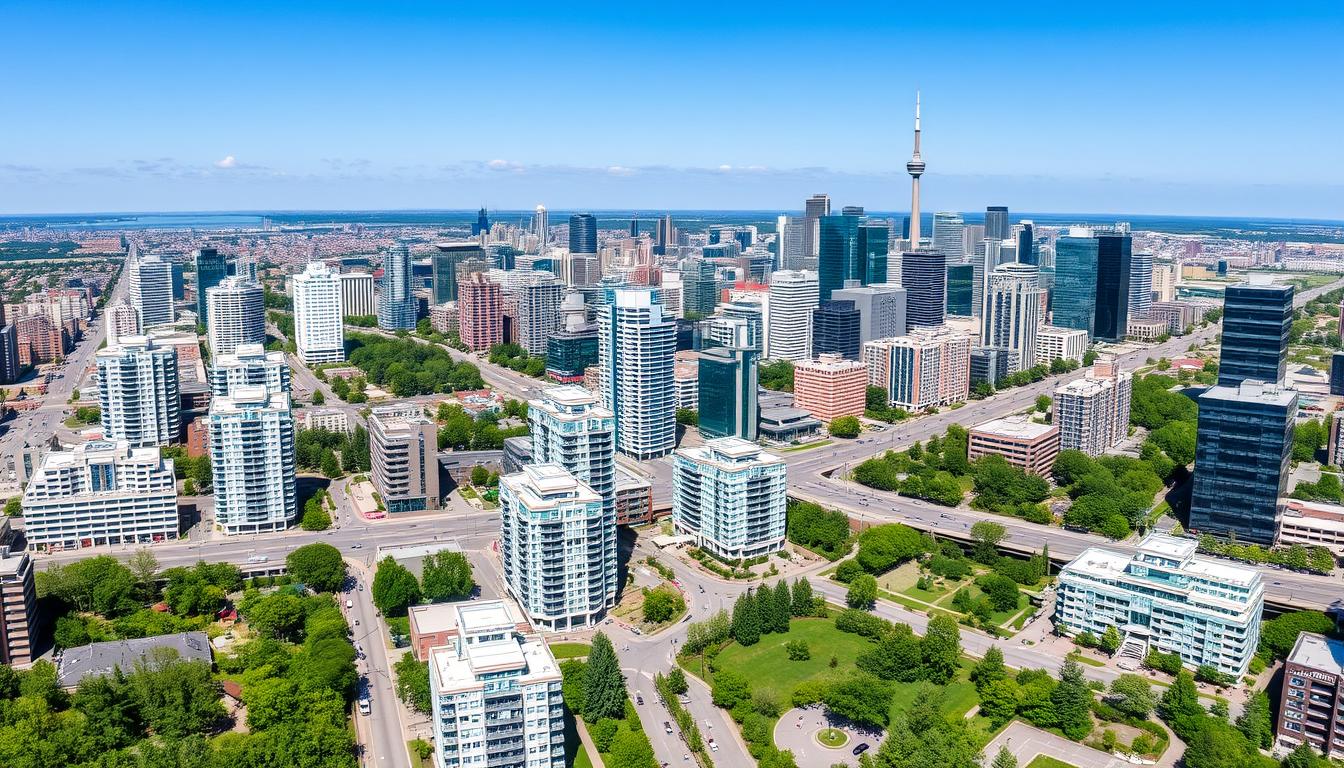
Key Takeaways
- Identify the neighbourhoods in Toronto that are poised for significant growth and appreciation.
- Understand the current market trends and economic factors influencing property values in the city.
- Explore transit-oriented development areas where transportation infrastructure is driving real estate demand.
- Discover the emerging tech hubs and their impact on residential and commercial real estate.
- Analyse high-yield investment areas to maximize your return on investment (ROI).
- Recognize gentrification patterns and identify investment opportunities in up-and-coming neighbourhoods.
- Leverage the impact of commercial development and urban planning on residential property values.
Understanding Toronto’s Real Estate Market Dynamics
The Toronto housing market has seen a lot of interest lately. It’s a lively city with a real estate scene that changes a lot. Knowing the current trends and how the economy affects them is key for smart investors.
Current Market Trends and Valuations
Home prices in Toronto have been going up steadily for years. Now, the average home price is $1.2 million, showing the city’s appeal. This rise is due to a few things like not enough homes, more people, and investors wanting in.
Impact of Economic Factors on Property Values
The Toronto housing market is shaped by the economy. Things like interest rates, jobs, and how confident people are all matter. When the economy is doing well, homes tend to cost more and sell faster. But, if the economy slows down, the market can slow down too.
Market Cycle Analysis
- Expansion Phase: When the economy grows, the Toronto housing market expands too. This means more people want homes, prices go up, and investors are active.
- Peak Phase: At the market’s peak, prices might not rise as fast. The risk of homes being overvalued grows.
- Contraction Phase: If interest rates go up or there’s a recession, the market contracts. This makes the market cool down and prices might drop.
- Trough Phase: Then, the market hits a trough. Prices level out, and things slow down before the next growth starts.
Getting the real estate cycles in Toronto is key for investors. It helps them buy and sell at the right times, making more money and avoiding big losses.
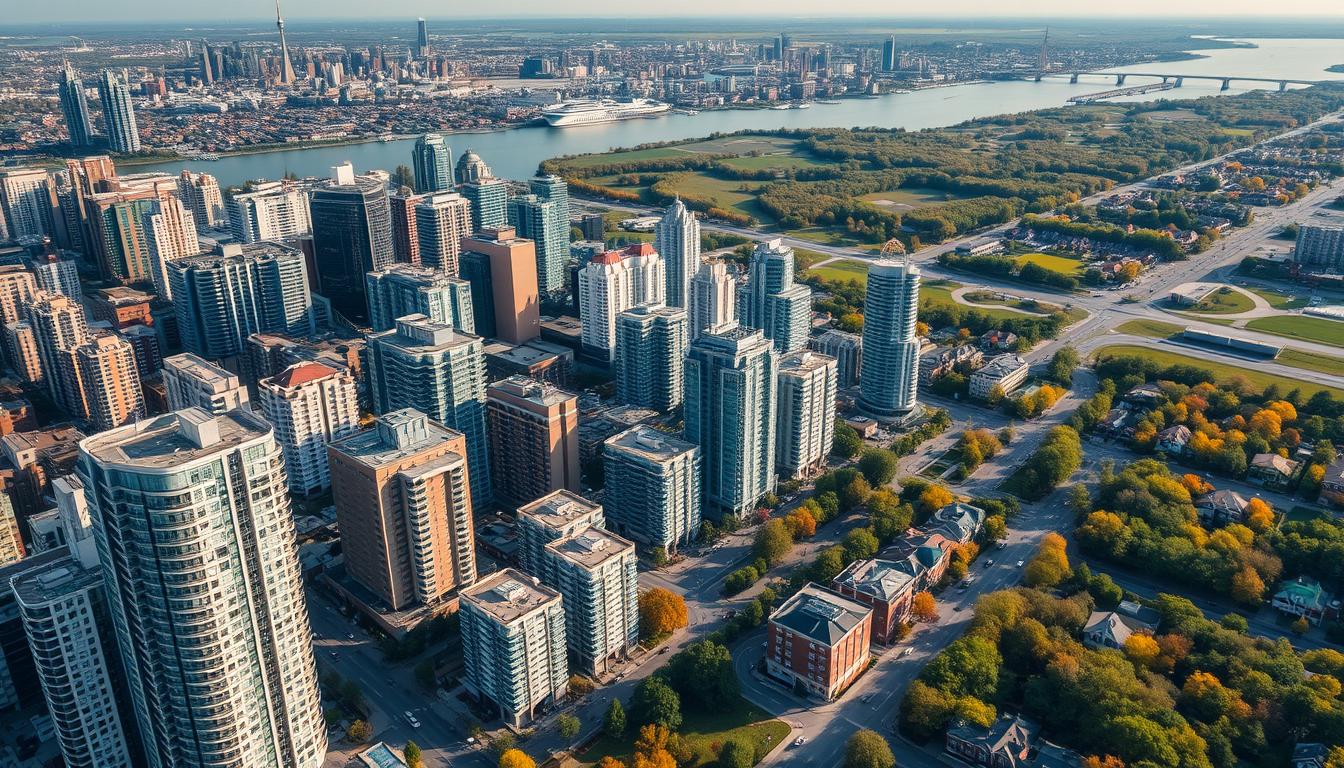
| Metric | Current Value | Historical Average |
| Average Home Price | $1,200,000 | $950,000 |
| Rental Yield | 4.2% | 3.8% |
| Days on Market | 28 | 35 |
| Inventory Levels | 2.5 months | 3.2 months |
Top Growing Neighbourhoods for Investment in Toronto
Toronto’s real estate market is always changing. Smart investors look for the city’s up-and-coming areas with high growth potential. By finding these areas, investors can make good money through smart buying.
Some of the top growing neighbourhoods in Toronto with great property appreciation are:
- Liberty Village: This area used to be an industrial zone but has changed a lot. It now attracts young professionals and tech companies with its mix of homes, workspaces, and fun activities.
- The Danforth: Known for its Greek community, this area is growing fast. It has new cafes, shops, and parks, making it a popular growth area.
- Leslieville: This area used to be for working-class families but now it’s a creative hub. It’s home to independent shops, artists, and young families, making it an up-and-coming Toronto neighbourhood.
These areas are growing because of many factors. They have more people, better infrastructure, and new businesses. Knowing about these areas helps investors make smart choices and get good returns.
| Neighbourhood | Key Factors Driving Growth | Average Property Price Appreciation (5 years) |
| Liberty Village | Conversion of former industrial spaces, influx of tech companies, development of residential and commercial units | 48% |
| The Danforth | Revitalization of main street, increased amenities and lifestyle offerings, proximity to downtown | 41% |
| Leslieville | Gentrification, growth of creative industries, development of new residential and mixed-use projects | 53% |
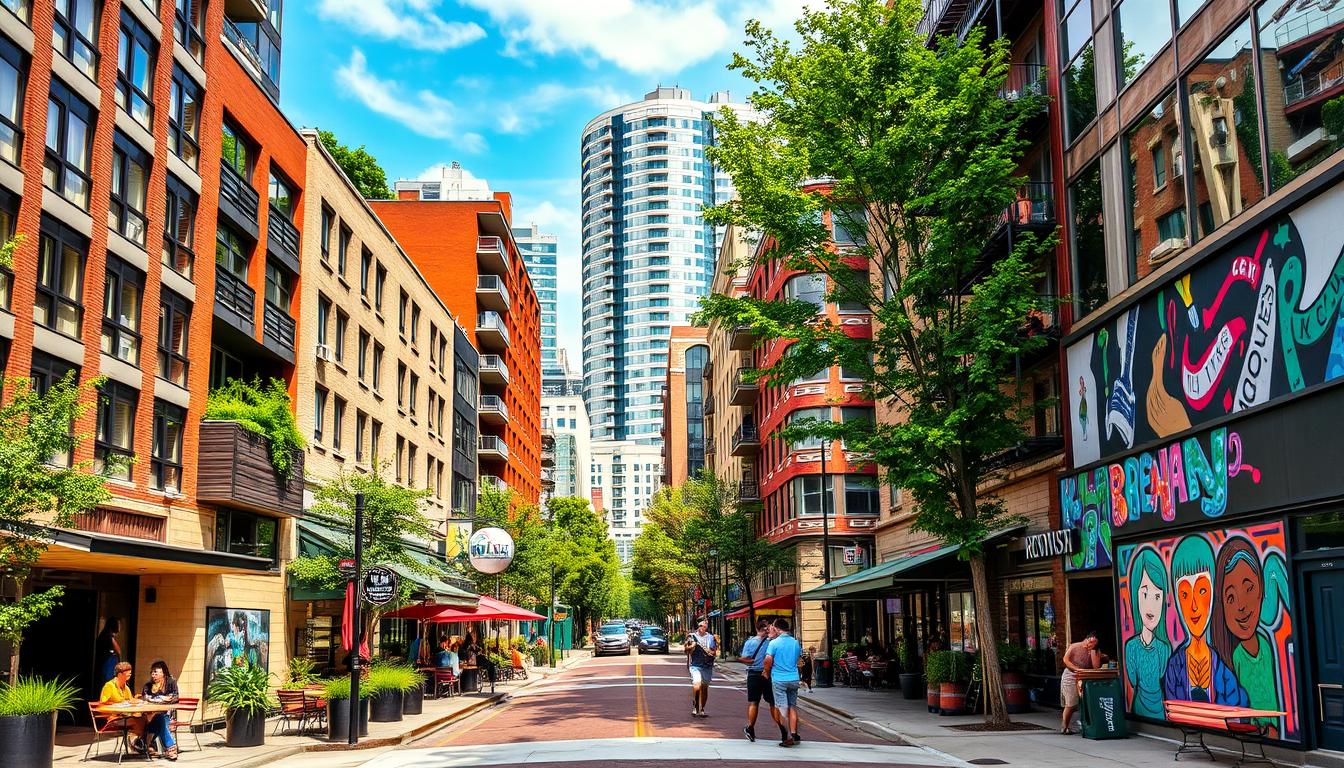
“The mix of urban growth, lifestyle options, and more people is making these up-and-coming Toronto neighbourhoods very valuable. Investors who spot these trends will likely do well in the long run.”
Transit-Oriented Development Areas: Where to Watch
As Toronto grows its public transit, smart investors watch areas set to benefit. Transit-oriented development (TOD) boosts property value. Knowing which neighborhoods are next can lead to big wins.
New Transit Lines and Property Appreciation
The Eglinton Crosstown LRT and Yonge subway line extensions are changing values. Places like Eglinton West and North York Center are hot. Buyers and investors see the value of being close to new transit.
Future Infrastructure Projects
- Expansion of the Bloor-Danforth subway line
- Development of the Downtown Relief Line
- Extension of the Waterfront LRT
These projects will push property values up. They’re key spots for investors to watch.
Accessibility Scores and Property Values
There’s a clear link between transit access and property prices. Areas with high Walk, Transit, and Bike Scores are more valuable. Investors track these scores to find growth areas.
“As Toronto’s transit network expands, the value of properties in well-connected neighborhoods will only continue to rise. Savvy investors would do well to keep a close eye on these transit-oriented development areas.”
Emerging Tech Hubs and Their Impact on Real Estate
Toronto’s tech industry has changed the city’s real estate. The growth of innovation districts has increased real estate demand in tech areas. This has reshaped investment chances all over the city.
More tech companies and startups have moved in. This has boosted areas like King West, Liberty Village, and the MaRS Discovery District. These tech hubs attract young professionals, raising property values and rental prices nearby.
- King West has seen a quick rise in luxury condos and office spaces, meeting the tech workforce’s needs.
- Liberty Village has changed from an industrial zone to a lively mixed-use area. It’s now full of tech startups and co-working spots.
- The MaRS Discovery District, a top innovation hub, has helped grow the Waterfront and downtown areas.
As the Toronto tech industry keeps growing, real estate will feel the effects more. Investors and buyers should watch these innovation districts. They promise big chances for growth and rental income in the future.
“The rise of tech hubs in Toronto has transformed the city’s real estate market, creating new pockets of growth and investment opportunities.”
Investment in Toronto: Analysis of High-Yield Areas
Investing in Toronto’s real estate market can be very profitable. But, finding the best areas needs a good understanding of the city’s neighbourhoods. We’ll look into the ROI, rental yield, and capital growth in some top areas of the Toronto real estate market.
ROI Calculations by Neighbourhood
Not all areas in Toronto offer the same ROI. Our study shows that Leslieville, Liberty Village, and Roncesvalles lead the pack. They give investors better returns than the city average. We’ve analyzed the numbers to help you make the most of your investment.
Rental Yield Potential
Rental yields are also key when investing in Toronto real estate. Areas like Yorkville, Church-Yonge Corridor, and Deer Park have strong rental demand. This means investors can earn steady income. Our research provides the details you need to make smart choices.
Capital Growth Projections
Capital growth is crucial for long-term wealth in the Toronto real estate market. We’ve looked at market trends, infrastructure, and demographics. This has helped us find areas like Corktown and Thorncliffe Park for great investment potential.
| Neighbourhood | ROI | Rental Yield | Capital Growth Projection |
| Leslieville | 18% | 4.2% | 12% (5 years) |
| Liberty Village | 16% | 4.5% | 15% (5 years) |
| Roncesvalles | 17% | 4.3% | 13% (5 years) |
| Yorkville | 14% | 4.9% | 10% (5 years) |
| Church-Yonge Corridor | 15% | 4.7% | 11% (5 years) |
| Deer Park | 16% | 4.6% | 12% (5 years) |
With these insights, smart investors can succeed in the Toronto real estate market. They can focus on high-yield areas and increase their returns.
Gentrification Patterns and Investment Opportunities
Toronto’s urban landscape is changing fast with gentrification. This change brings new chances for investors to make money. Knowing about neighbourhood revitalization and property value increase is key for smart investing.
As more people move in, property values go up. Areas once affordable are now in demand. Investors who spot these trends can make good money.
Identifying Gentrification Hotspots
To find the best places to invest, watch for these signs of gentrification in Toronto:
- Increasing median household incomes
- Rising property values and rental rates
- New businesses and amenities
- Improved infrastructure and public transit
- More young professionals and families
By tracking these signs, investors can find areas ready for growth. They can then profit from the increase in property values.
Strategies for Gentrification-Driven Investments
Smart investors use these strategies in Toronto’s changing neighbourhoods:
- Look for undervalued properties in up-and-coming areas
- Invest near new transit hubs or infrastructure projects
- Find emerging commercial and employment hubs
- Consider multi-unit properties for rental income
- Watch for zoning changes and development plans
By staying ahead, investors can benefit from Toronto’s real estate market.
| Neighbourhood | Current Median Home Price | Projected 5-Year Price Appreciation |
| Regent Park | $650,000 | 25% |
| Leslieville | $950,000 | 18% |
| Junction Triangle | $800,000 | 22% |
The table shows some of Toronto’s gentrification hotspots. It highlights the chance for property value increase. By being informed and strategic, investors can benefit from Toronto gentrification.
“Gentrification is a complex phenomenon that requires a nuanced understanding of the local dynamics. Savvy investors who can identify emerging trends and act accordingly will be poised to reap the rewards.”
Commercial Development Impact on Residential Properties
The link between commercial growth and home values in Toronto is key for smart investors. New business areas and job centers change neighbourhoods, affecting home prices and rental income.
New Business Districts
Toronto’s cityscape is always changing. New mixed-use areas, like the Distillery District and East Harbour, attract businesses and workers. This boosts demand for homes near these areas.
Employment Growth Areas
Toronto’s economy is booming, thanks to its commercial real estate Toronto market. Places like MaRS Discovery District and Vaughan Metropolitan Centre are creating more jobs. This drives up demand for mixed-use developments nearby.
| Neighbourhood | Avg. Residential Price | Rental Yield | Employment Growth |
| Distillery District | $800,000 | 4.2% | 18% (2018-2021) |
| East Harbour | $725,000 | 3.9% | 22% (2019-2022) |
| MaRS Discovery District | $900,000 | 4.5% | 27% (2017-2020) |
| Vaughan Metropolitan Centre | $675,000 | 3.7% | 19% (2018-2021) |
The table shows how commercial growth affects homes in Toronto. It links job growth, rental income, and home prices in new business areas.
As Toronto’s commercial scene evolves, investors who keep up will profit. They’ll find opportunities in mixed-use developments and job-rich areas for residential property near business districts.
Urban Planning and Future Development Zones
Toronto’s urban landscape is always changing. The city’s planners and authorities aim for a more vibrant, livable, and green future. This section looks at the upcoming plans and zones that will shape the city’s real estate in the future.
The expansion of Toronto’s transit network is a big focus. New subway and light rail lines, like the Eglinton Crosstown LRT and the Ontario Line, are being built. Areas near these hubs will likely see more development and rising property values.
Investors should watch for zoning changes and land-use designations in these areas. These can unlock big growth opportunities.
The city also wants to create complete communities. This means areas with homes, shops, and parks. Projects like Waterfront Toronto and the Keele-Finch Innovation Corridor are part of this vision.
These zones offer investors a chance to be part of Toronto’s long-term vision. They aim for a more livable and sustainable city.
FAQ
What are the current market trends and valuations in Toronto’s real estate market?
Toronto’s real estate market has seen big growth lately. Property values keep going up. This is because of more people moving in, the economy growing, and not enough homes.
Knowing the current trends and values is key for smart investments.
How do economic factors impact property values in Toronto?
Economic conditions like interest rates, inflation, and jobs affect Toronto’s property values. These changes can change how much people want to buy, how affordable homes are, and the market’s health.
What are the top growing neighbourhoods for investment in Toronto?
Some areas in Toronto are becoming popular for investing. New projects, changes in who lives there, and cool amenities are making these places grow.
How can transit-oriented development areas in Toronto impact property values?
Toronto’s growing transit system is changing property values. Being close to public transport is very appealing. This can make homes more valuable and in demand.
What is the impact of the tech industry on Toronto’s real estate market?
Toronto’s tech boom is changing the real estate scene. More tech companies mean more demand for places to work and live. This is especially true in tech hubs.
How can investors analyze the potential for high-yield areas in Toronto’s real estate market?
To find good investment spots, look at ROI, rental income, and how values might grow. This helps investors make smart choices.
What are the investment opportunities associated with gentrification patterns in Toronto?
When areas in Toronto get gentrified, property values often jump. Spotting gentrification can lead to finding new investment chances in these areas.
How can commercial development impact residential property values in Toronto?
New business areas and job centers can boost nearby home values. This connection between work and living spaces can open up investment chances.
What insights can be gained from Toronto’s urban planning initiatives and future development zones?
Keeping up with Toronto’s urban plans and future zones can help investors. Knowing the city’s growth plans can show where to invest for the best returns.
Your Trusted Real Estate Agent in Toronto
Looking for expert assistance to buy or sell your property in Toronto? Contact us today to work with a professional real estate agent who knows the market inside and out!
Get in TouchBusiness Contact Details
- Address: 305 Milner Ave Unit # 312, Toronto, ON M1B 3V4, Canada. Get Direction - Google Map
- Contact Name: Sivage Sivagumaran
- Phone: +1 416-553-8902
- Email: [email protected]
Visit our website at SivageRealty.ca for the latest property listings and personalized services. Let us help you turn your real estate goals into reality. Your dream property is just a call away!
Disclaimer:
The content provided in this blog is for informational purposes only. We recommend consulting with a qualified professional before making any decisions based on the information provided. If you have any questions or concerns, please don't hesitate to reach out to us. Our contact information is available on the Contact page.


